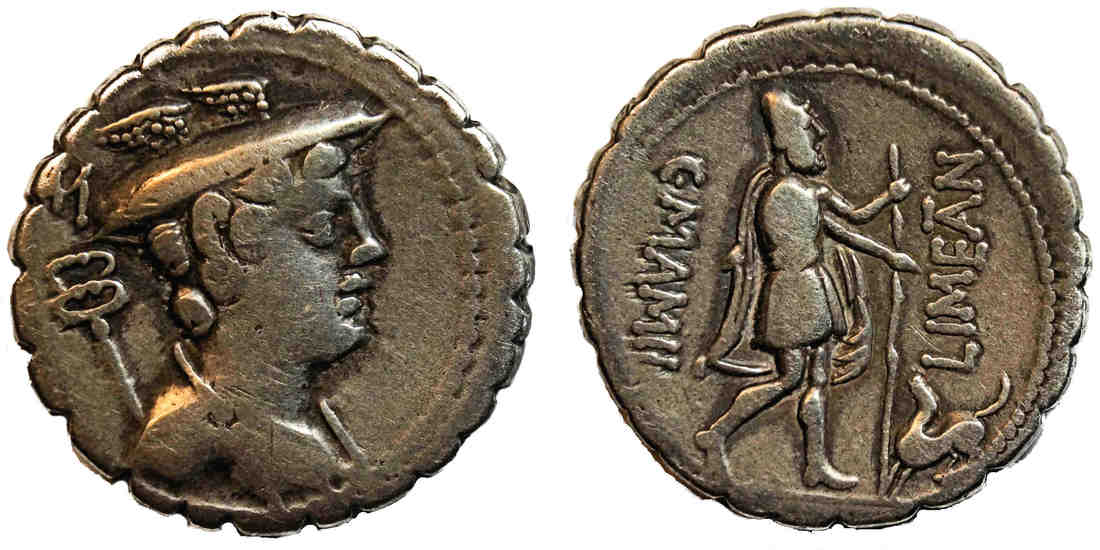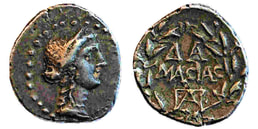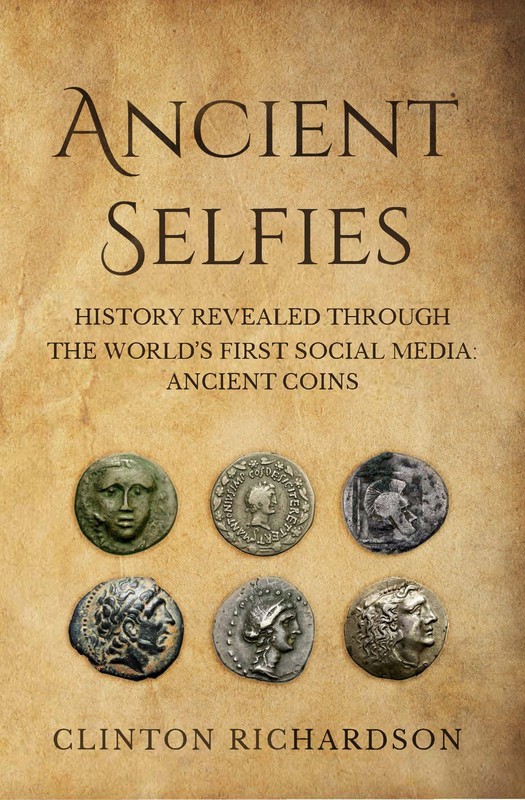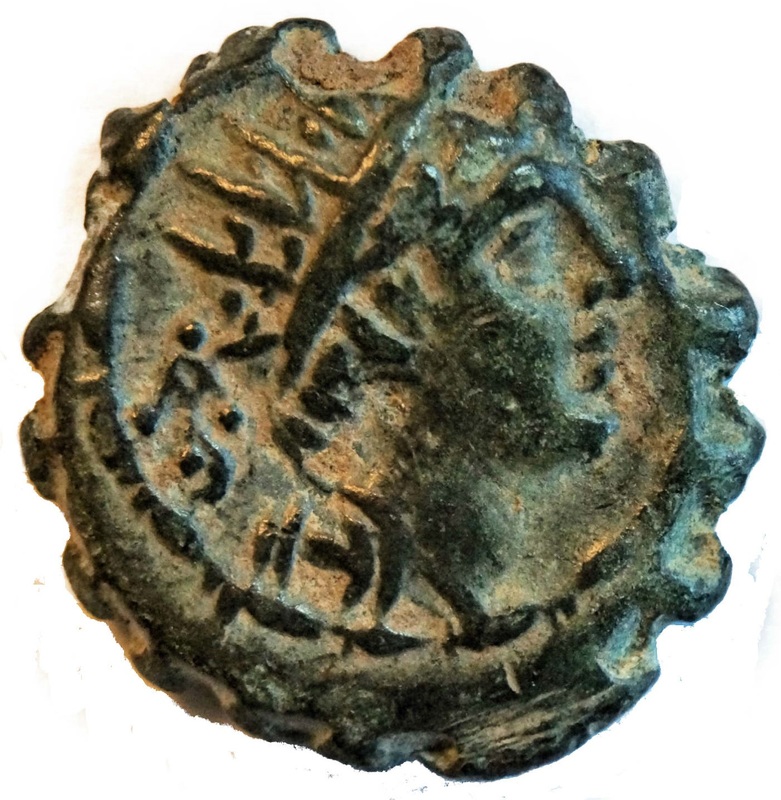|
Ancient money's silent witness to history and how it influences our lives today is the subject of today's post. The image displayed above is from a coin was issued by a Roman Senator in 71 BC. In that year, Rome’s legions finally and violently quashed a massive slave rebellion on the Italian peninsula. The coin, as you can see, portrays a legionnaire holding a prostrate and defeated slave. The coin was a comfort to Rome’s citizens and a warning to its many slaves. You may have heard about the rebellion. Bestselling author Howard Fast wrote about it in the 1950s and actor Kirk Douglas turned Fast’s book into a blockbuster movie in 1960. As the story goes, a Thracian mercenary named Spartacus is enslaved and sent to the gladiatorial school of Lentulus Batiatus in Capua in the year 73 BC. Plans were to include him in gladiatorial bouts hosted throughout Rome’s empire after his training. Instead, he masterminds an escape and defeats all challenges thrown at him, dispatching Roman legion after Roman legion and accumulating over a two year period nearly 100,000 followers. His slave nation made camp on Mount Vesuvius near modern day Naples and earned international notoriety for its resilience. Knowing Rome must crush them to survive, Spartacus and his army of former slaves made arrangements to escape from the peninsula. But they failed. While trying to depart, the legions of Marcus Crassus and Magnus Pompey converge on them and defeat Spartacus and his armies in a crushing battle. After the defeat, Crassus crucifies 6,000 captives from the battle, all former slaves, while marching the rest of them 350 miles from the battle site to Rome. The number equates to about 17 crucifixions per mile, spreading them apart far enough so that the screams of each crucified slave could not be heard by the other slaves as they marched under the watchful eyes of Crassius’ legions. What you probably don’t know is that Howard Fast had to self-publish his book about Spartacus because his name appeared on Senator McCarthy’s black list of communist sympathizers. The Committee thought Fast and the story were too sympathetic to communist ideals. Even with the impediment of self-publishing, however, Spartacus quickly became a number one bestseller on the New York Times Bestseller List. And then the story of Spartacus’ struggle took on new meaning and managed to impact modern America in a surprising way. Kirk Douglas, annoyed at losing the lead role in Ben Hur to Charleston Heston, bought the film rights to Fast’s book and hired the incomparable Dalton Trumbo to write the screen play for his movie. Trumbo had been imprisoned for refusing to testify to the McCarthy’s Un-American Affairs Committee and was blacklisted by the motion picture industry. When it came time to release the film, Douglas made another bold move and put Trumbo’s name in the movie credits. Hedda Hopper and other influential media people panned Douglas and the move as un-American. Protesters appeared at the opening. But the movie nonetheless became an instant popular success marking a defeat for McCarthyism. When President Kennedy attended a showing and commented positively on the film, an important victory for American freedom was sealed. Spartacus lost his own battle for freedom in 71 BC but centuries later his story helped free Dalton Trumbo and Americans everywhere from a tyranny of their own. The past matters. Ancient coins like the one above can remind us of important past events that can and do still impact our modern world.
_ _ _ _ _ _ _ _ _ _ Next week we start our Kenyan Safari series. What is it like to spend two weeks in the African wild? What do you experience and see when you are there? Check out our Safari 1: The Hunt next Thursday. The coins pictured are from the Ancient Selfie collection and featured in Ancient Selfies - History Revealed Through the World's First Social Media. All coin photos and text are copyright Clinton Richardson. See more coin images at TrekPick.com on the Coins page. If you like these posts, please tell your friends about the Venture Moola blog at Readjanus.com. For more pictures of the cormorant or the great blue herons whose territory he is invading, see the Jurassic Cove Gallery at TrekPic.com under the heading New. Feel free to share this blog. The more readers the better. Click here to subscribe to a weekly email that tells you when we issue new entries. Or, click in the column to the left to follow us on Facebook or Twitter. You would be angry too if someone left you out in the woods for 50 years. Thousands of years ago, Odysseus was cursed to wander the seas for just ten years and he arrived home fit to be tied. I can imagine him feeling like this ancient Oldsmobile looks. Tired and worn and ready for a fight. The Odyssey depicts him as such as he sneaks back into town to assess the situation at his home. The coin, issued in 82 BC by a Roman senator serving a one year commission as moneyer, shows Odysseus being recognized by his old dog Argus as he finally returns to his home. The fact that this classic Greek scene appears on a Roman coin attests to the power this classic Greek story had in Roman times. Eighty-two BC was an unsettled time in Rome. Sulla had just defeated the Marians to take control of Rome but the empire was largely ruled by the Greek Mithradates, who had taken advantage of Rome's civil unrest to recapture much of Greece. Consequently, the Greeks were very much on Roman minds. I am not sure how the Roman god Mercury (who graces the front of the coin) fit in the Roman mind with the Greek hero Odysseus. Perhaps it was a way to claim Roman connection with the heroic traits of Odysseus or those of the more modern Greek hero Mithradates. Or perhaps, Limentanus, the issuer, traced his family to Mercury. Many Roman families included Roman or Greek gods in their family trees. Julius Caesar's family claimed affiliation with the Greek goddess Venus. She appears on many coins issued in his name. (His associates also claimed he ascended to the heavens when a comet appeared in the skies shortly after his death.) Our modern society does something similar, like using the likeness of Mercury on an American automobile. You would expect this car to be swift if it is named for Mercury. Or, co-opting a Greek goddess like Nike to sell shoes. Of course, in Nike's case the association is more abstract. They use a swish as their logo instead of the goddess' image. Interestingly, Nike personified victory to the ancient Greeks and Romans, not speed. Odysseus wandered far and wide on his arduous ten year journey home, suffering imprisonment, ship wrecks and losing his entire crew. He faced great temptations. He even visited hell, the Greeks called it Hades, where he saw the tortured remains of fallen heros. A junk yard can show you remains of fallen automobiles adorned with godly symbols and wearing the ravages of time. I guess you can find the old Greeks most anywhere if you look hard enough. _ _ _ _ _ _ _ _ _ _
Next week's post is about Why Spartacus Matters. Kirk Douglas, Joe McCarthy, Dalton Trumbo, a Roman slave and how they all interconnect to make a big impact on 20th century America. All photos and text are copyright Clinton Richardson. The images are from the author's Auto Afterlife and Ancient Selfies Galleries at the Trekpic.com. You can access them from the New and Coins pages. Next week we talk about Prepping for Kenya. If you like these posts, please tell your friends about the Venture Moola blog at Readjanus.com. For more pictures of the cormorant or the great blue herons whose territory he is invading, see the Jurassic Cove Gallery at TrekPic.com under the heading New. And, feel free to share this blog. The more readers the better. Click here to subscribe to a weekly email that tells you when we issue new entries. Or, click in the column to the left to follow us on Facebook or Twitter.  Alexander the Great returned to the city of Ecbatana in the fall of 324 BC for a three-month binge of drinking and entertainment. The city was an appropriate cite for a celebration. Alexander had first been there after the Battle of Gaugamela. And, it was outside the city where Darius III, the great Persian emperor and warrior, had been captured. This secured Alexander's claim to the Persian Empire and opened the East as far as India to his conquest. Alexander had 3,000 entertainers and artists brought from Greece to mark his conquest with a weeks long celebration. But tragedy struck during the event. Alexander’s closest companion and suspected lover, Hephaestion, fell ill and died after drinking heavily and eating a fowl. Glaucus, his doctor, was at the theater at the time and unable to help. Distraught, Alexander ordered the doctor crucified and the tails and manes of all the horses to be cut. The celebration was over. The city of Ecbatana was also the site where this coin was minted. It shows the great Greek hero Heracles on the front, fashioned in the image of Alexander himself, wearing a lion’s head for a headdress. On the back is Zeus, the greatest of the Greek gods and father to Heracles seated on a throne holding an eagle and a scepter. The coin and its imagery served a purpose in Alexander's plans for conquest. He used it to portray himself as a god-like ruler to his friends and foes. The lion’s headdress and portrayal of his profile as the hero Heracles provided a powerful graphic image to everyday citizens that the new ruler was to be respected and obeyed. The portrait of Zeus’ on a throne with a powerful eagle on his hand, re-enforces the message of power and connects Alexander to the greatest of the Greek gods. For more about this Ancient Selfie and others check out the book Ancient Selfies - History Revealed Through The World's First Social Media: Ancient Coins or our website at ancientselfies.com. About the coin: Alexander at Ecbatana. Silver obol of Alexander the Great minted in Ecbatana between 336 and 326 BC. 10.3 grams. 67 mm. Acquired from Forum Ancient Coins, Morehead City, North Carolina in 2006. Featured in Ancient Selfies - History Revealed Through The World's First Social Media: Ancient Coins, a Finalist in the 2017 International Book Awards. As with many ancient coins, there is some debate about who is represented on the face of this coin issued in a part of Greece controlled by Marc Antony in the mid-30s BC during the Second Triumverate. Some believe the image of Aphrodite on the front is in the image of Cleopatra, Antony's lover, mother of his children and co-leader of his combined Roman and Egyptian armies and navies at the fateful battle of Actium.
The coin coin depicts the Greek goddess of love, beauty and procreation. It is believed to have been issued by Marc Antony and Cleopatra to pay their legions. The choice of Aphrodite for the coin would have been appropriate for a queen whose rise to power within a Roman man's world began while she was in exile fighting for her survival in Cyprus. This same island that launched Cleopatra onto the world stage also housed one of the two principal cult sites dedicated to Aphrodite and was believed by the Greeks to have been the birth site of the goddess. It is not hard to believe that the image was intended to honor the great queen who was worshiped as a goddess within her native Egypt. Most often she was portrayed as the Egyptian goddess Isis, who was worshiped as the ideal mother and wife, and goddess of children. A remarkable woman by any account, Cleopatra was the last of the Greek Ptolemy dynasty that ruled Egypt for 300 years. She ruled the wealthiest empire in the Western world with the most advanced arts, the most impressive cities, and the most luxurious lifestyles for its ruling class. She was also among the best educated rulers of her time, benefiting from being raised in a culture where women had more access to education than did their Roman counterparts. She could speak fluently in many languages and was the first Ptolemy able to speak to her Egyptian subjects in their native tongue. Cleopatra was at the height of her power when this coin was issued. With Marc Antony at her side, she had been proclaimed Queen of Kings and Queen of Egypt, an empire that included Egypt and much of the Levant and Greece. Her son Caesarion had been proclaimed by Antony to be the legitimate son and rightful heir of Julius Caesar. Would you like Marc Antony to send you a picture of Cleopatra, his co-ruler, lover and mother to his children? You can get this selfie and selfies from other ancient rulers by purchasing Ancient Selfies - History Revealed Through the World's First Social Media: Ancient Coins. Get the book in eBook or paper at Amazon.com or check out the book web site at at http://www.ancientselfies.com/. Details: Achaea, Patrae. Mid-30s BC. Silver hemidrachm. Obverse: Head of Aphrodite right wearing stephane, resembling Cleopatra? Reverse DA/MACIAC and monogram within wreath. 16 mm. 2.32 grams. References: BCD 525; SNG Copenhagen 154. Image and content copyright Clinton Richardson. Get Ancient Selfies in eBook or paper at Amazon.com or check out the Ancient Selfies web site at at http://www.ancientselfies.com/. If you like these posts, please tell your friends about the Venture Moola blog at Readjanus.com. And, feel free to share this blog. The more readers the better. Click here to subscribe to a weekly email that tells you when we issue new entries. Or, click in the column to the left to follow us on Facebook or Twitter. How would you like to receive a selfie from Julius Caesar or Cleopatra or Alexander the Great? Imagine how much more interesting the Romans and ancient Greeks would be if you could interact with them on social media. Imagine what you could experience and learn from seeing the selfies of leaders of the ancient world. Impossible you say? Romans did not have cell phones or the Internet. Heck, they did not even have soap. Social media is a modern phenomenon, right? Think again. The ancients invented the first social media and left their selfies for everyone to see. And these are not just ordinary selfies. They are engraved on the coins the ancients invented and used to distribute their images wherever their commerce took them. You can see them in Ancient Selfies, the 2017 International Book Awards Finalist in History that takes you back to ancient Greece, Persia and Rome in a new way - through the images commissioned by their rulers for their coins. For populations that were largely illiterate, these hand stamped coins made from hand engraved dies delivered images of their ancient rulers and the things that were happening in their lives. Their rulers understood the power coins had to communicate and used them to convey messages and shape impressions.
Thousands of years later, these very personal images enable us to travel back through the ages to get a unique glimpse into our past. The remarkably beautiful images on these coins, together with their stories, provide a unique and tangible way for us to connect directly with our past. For more about Ancient Selfies - History Revealed Through the World's First Social Media: Ancient Coins check out the Ancient Selfies web site at www.ancientselfies.com. Or, start with the readjanus.com/ancient-selfies.html page. Above image copyright Clinton Richardson is from the coin issued by Julius Caesar just days before his assassination. See the coin and read about Caesar in Chapter 4 of Ancient Selfies, available in color eBook and B&W print at Amazon.com. A version of this entry also appeared in the Ancient Selfies blog at ancientselfies.com/blog. If you like these posts, please tell your friends about the Venture Moola blog at Readjanus.com. And, feel free to share this blog. The more readers the better. Click here to subscribe to a weekly email that tells you when we issue new entries. Or, click in the column to the left to follow us on Facebook or Twitter. Introducing the Ancient Selfies gallery to Readjanus.com. Don't have time to read the International Book Awards Finalist in History but would like to see the coins. Check out the Photos link at Readjanus.com and check out more ancient selfies engraved on coins.
Above you will find coin fronts from the three most powerful people of their age, Marc Antony, Cleopatra and Octavian Augusta. She was a polymath who spoke multiple languages and captivated both Julius Caesar and Marc Antony and very nearly created a long term empire of her own from a civil war torn Rome. From our shameless self-promotion department comes this expansion of an earlier post noting that our recent book - Ancient Selfies - has been named a Finalist in the history category of the 2017 International Book Awards. Thanks to the judges who reviewed the book and to Julius Caesar, Cleopatra, Homer and others who offered their endorsements in the front pages. :-)
Thanks also to all those ancient leaders who commissioned their selfies onto their hand-stamped coins to leave an indelible record of their accomplishments and foibles. And to those who have given reviews on Amazon.com (all 5 Stars). We appreciate you all. And, thanks to all who encouraged the writing of the book, including John, who had this to say on Facebook: "Check out Clinton Richardson's new Book Ancient Selfies! This is an absolutely fascinating read. You think we have volatile political situations now you ought to read this. Unbelievable! And they put their faces on coins to remind you who was I charge. . . The first selfies. Who knew?" Available in Kindle eBook and paperback at amazon.com. More about the book and ancient coins at ancientselfies.com and readjanus.com. This month saw Ancient Selfies named as Finalist in the history category of the 2017 International Book Awards. More than 1,500 books were submitted in the IBA competition. Thanks to the judges who reviewed Ancient Selfies and to Julius Caesar, Cleopatra and others who offered their endorsements in the front pages. :-)
Available in Kindle eBook and print at Amazon.com. A FRIEND RECOMMENDED an audio book series from The Great Courses series over lunch the other day. The lecture series is called The World Was Never the Same: Events That Changed History. by J. Rufus Fears at the University of Oklahoma. As my friend described it, the course reviews history through events, like the discovery of America by Christopher Columbus, that dramatically changed the course of human events. The most recent event treated was 911 and all the changes it has brought about in lives around the world. Most would agree that 911 changed the world as we knew it. I think, my friend continued, that the line in the sand President Obama drew in 2012 and failed to back up may become the next event that changed history when people look back on our time. Since then, he noted, the war in Syria has become unconventionally brutal with chemical weapons, bombing of civilians and health care facilities with the resulting destruction of a nation state that has sent unprecedented numbers of immigrants fleeing into Europe. If you watch the news, you know much of the rest. Turmoil in the Middle East, ISIS exporting terror throughout Europe and beyond, budget strains and humanitarian crisis throughout Europe followed by rising nationalism that fueled BREXIT and the rise of an electorally significant right wing party in Germany for the first time since World War II. Unsettling stuff, to be sure. But what is a line in the sand? And, where did the phrase come from? First, to set the record straight, there was no Obama "line in the sand" in 2012. He drew a red line instead. In a press conference on August 20,2012 President Obama stated: "We have been very clear to the Assad regime, but also to other players on the ground, that a red line for us is we start seeing a whole bunch of chemical weapons moving around or being utilized. That would change my calculus. That would change my equation. . . . We have communicated in no uncertain terms with every player in the region that that’s a red line for us and that there would be enormous consequences if we start seeing movement on the chemical weapons front or the use of chemical weapons. That would change my calculations significantly." This was followed by the use of chemical weapons in Syria without an American response calling into question America's resolve and, some believe, accelerating the escalation in the horrible violence and war crimes that have engulfed Syria and the Middle East.
So, where did the line in the sand originate? One candidate, the recipient in this case, is identified on the coin above. Antiochus IV was the Seleucid Emperor who ruled a vast empire to the east of Rome that included Syria. In 168 BC, he launched a campaign to annex Alexandria to his conquest of Egypt. He had successfully subdued the remaining part of Egypt in a preemptive strike in 170 BC. This second campaign, however, was thwarted before it could reach the city. Roman Senator Gaius Popillius Laenas confronted Antiochus and demanded he withdraw or face war with Rome. While Antiochus was stalling for time, Laenas drew a circle around him in the sand and demanded a decision before Antiochus left the circle. The Seleucid Emperor conceded and the phrase "line in the sand" came into being. Wikipedia describes both the red line and the line in the sand as figurative points of no return or as limits beyond which safety can no longer be assured. A poker player might call it a bluff, at least when it is not backed up with action. And, of course, that's always the question when someone draws a line. Is it really a bluff? Was Laenas' line in the sand a bluff? We will never know. The Syrian he was facing did not challenge his threat, choosing instead to retreat and leave Alexandria alone. Image courtesy of the Ancient Selfies Collection. Coin front of Antiochus IV, Seleucid Emperor, 175 to 164 BC. More about Antiochus and other ancient rulers in Ancient Selfies: History Revealed Through The World's First Social Media to be published later this year. IF YOU FOLLOW THIS BLOG and wonder who identified the most coins from our September 19 entry Who do you know? wonder no longer. The winner and recipient of the proof copy of Ancient Selfies is John Runningen, Atlanta-based Principal with Commenda Capital.
John identified six of the faces on the coins. If you number the rows (1-4) and letter the columns (A-D) , those faces are Cleopatra (A1), Ptolemy I (A2), Philip of Macedon (B1), Marc Antony (B2), Alexander the Great (C2), Octavian Augustus (C3), Congratulations John! And, thanks to all who expressed interest in the exercise. The identified coins were hand stamped and issued in the four centuries before Christ. Cleopatra's coins was issued by her while she was under attack by the forces of her brother Ptolemy XIII on the island of Cyprus. Alexander's coin was issued from Ecbatana, the city where he threw a three month celebration of his great victory over the Persians at Gaugamela. These stories and others like them are the subject of Ancient Selfies, soon to be released in paper and ebook editions. |
the blog
Travel, history, and business with original photos.
your hostClinton Richardson - author, photographer, business advisor, traveler. Categories
All
Archives
July 2023
Follow us on Facebook
|
Check out Ancient Selfies a 2017 International Book Awards Finalist in History and 2018 eLit Awards Gold Medal Winner and
Passports in his Underpants - A Planet Friendly Photo Safari a 2020 Readers' Favorite Winner in Nonfiction
Site Copyright 2024 by Clinton Richardson


















 RSS Feed
RSS Feed